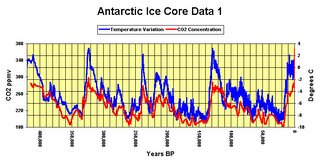
The C02 concentrations are measured in air bubbles within the ice core. Air temperature is approximated by measuring oxygen isotopes within the ice crystals themselves. Essentially, isotope fractionation occurs when water evaporates from the oceans - since oxygen-18 is heavier than oxygen-16, water molecules containing O-18 require more energy to be turned into water vapor than water molecules containing O-16. Thus the water vapor tends to be "isotopically lighter" than the oceans it has left behind. The water vapor travels poleward (due to temperature/pressure gradients) and encounters colder temperatures. Cold air can't hold as much moisture as warm air so the water vapor condenses and falls as snow or rain. Again, because it is heavier, the O-18 tends to precipitate sooner than the O-16. So it requires rather warm temperatures at all latitudes for O-18 to be found at the poles, and it can therefore be used as a proxy for air temperature.
The large, 100,000-year cycles in air temperature are what are referred to as glacial cycles. There is quite a bit of evidence that suggests that they are controlled by orbital parameters, such as the tilt of the Earth's axis, the ellipiticity of its orbit, and precession (the Earth wobbles like a top over a long time scales). Other factors are also clearly important, such as the distribution of land mass, which is important over much larger timescales (millions of years).
As I mentioned early, there is a strong correlation between atmospheric CO2 concentrations and air temperature, but from the plot above it is very difficult to determine what comes first - a change in CO2 or a change in temperature. (Methane also experiences similar oscillations.) And in fact there are reasons to believe that a rise in temperature can drive CO2 (and methane) concentrations - it can, presumably, force CO2 out of the oceans (and methane out of swamps that were previously frozen). But on the other hand, CO2 is also a "good" greenhouse gas that can trap solar radiation - more on that in a later post.
Two things to note from this figure: (1) the current interglacial period is the longest in the recent geologic past, and (2) CO2 concentrations are currently rising very rapidly and are much higher than any time in the past 400,000 years. I will also discuss this in a later post with respect to what's happened over the last 100 years - since the industrial revolution.
No comments:
Post a Comment